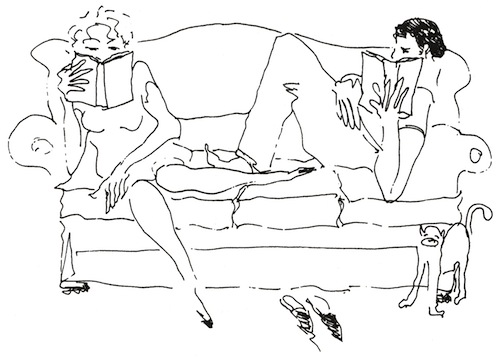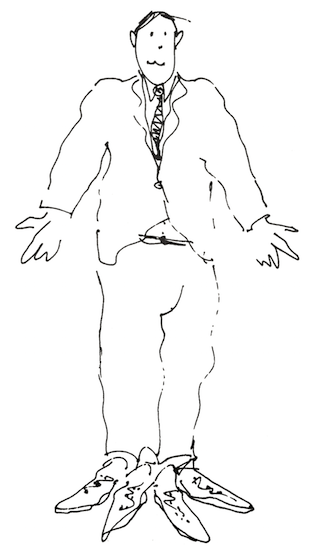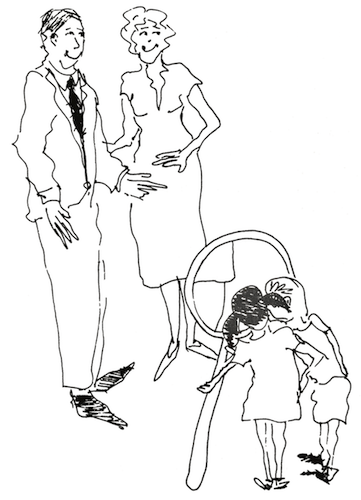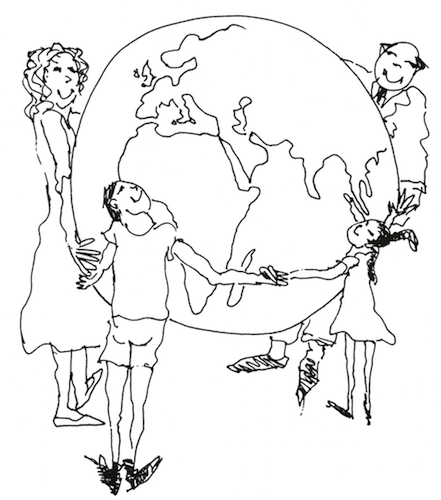26. Family of the Future
To prepare a context for looking at the family of the future, let us turn the calendar back and peek at the American family of 1900, at the turn of the present century. Two separate worlds existed then: one was of men; the other, women. There were very few bridges between them. The men’s world was considered superior and out of the reach of women. It was a world of competition, physical stamina, sexual prowess, intellectual pursuit, dominance, toughness, power, strength, and protection of the weak.
To fulfill this picture, men had to suppress their feelings and exaggerate their intellectual and physical prowess. This made them vulnerable to the ills that befall people who tie themselves up emotionally. Statistically, men have died earlier than women ever since the Industrial Revolution. To keep their worlds separate, the roles of both men and women were clearly defined.
The women’s world in 1900 was largely one of propriety, softness, sweetness, childbearing, caring for children, serving husbands, and being good cooks and homemakers. The woman was expected to make her world full through her home, husband, and children. The worst thing that could happen to a woman then was to become a spinster, or old maid, which was the same as being a social outcast. Many women chose unhappy marriages as a lesser evil. Today many women choose to remain unmarried if the choice is between marrying for marriage’s sake or remaining single. Women of today are waking up to the fact that they are no longer willing to settle for second-best.
The woman of 1900 repressed her intellectual side to remain marriageable. Society contended that men did not want to marry intellectual women. (Women are still crawling out from under this one.) Only the bravest and most venturesome women dared pursue higher education. Men, on the other hand, were encouraged to become as well educated as possible. Today, women are free to choose careers; it is part of the social ethic for women as well as men to be educated.

Turn-of-the-century women were expected to be virgins when they married. Men, on the other hand, were considered unmanly if they had not had sexual experience before marriage. The double standard was in full force. Today sexual expression prior to marriage is fast becoming the norm in many parts of society. We are still very naive as far as managing our sexual selves. We have not yet found a healthy balance.
The acceptable woman of 1900 was expected to go from her parents’ home to her husband’s bed. She was to accept the fact that her husband would be totally in charge of the family, the supreme authority. Laws barred women from owning property in some states. They depended totally on their husbands, fathers, brothers, and sons for their financial transactions and support. Today many women are heads of families or partners in their financial support.
At the turn of this century, men literally owned both women and children. Even the marriage vows reflected ownership. The woman was to love, honor, and obey her husband. He promised only to love and cherish her. Today people have many choices for making the marriage vows, and women and children are no longer anyone’s legal property.
Since early-century brides were expected to be virgins, husbands were supposed to educate them sexually. Not all men had enough information to be good teachers, though, and sex was therefore often unappealing. Appeal notwithstanding, women had no legal right to refuse their spouses sexually; in fact, not until the 1970s did state legislatures begin outlawing marital rape.
Family planning and birth control were other topics about which we knew little. Abstinence was the only birth control; abortions were illegal, very dangerous, and considered immoral. Today family planning is widely available, and many consider birth control acceptable and desirable. Abortions are legal, though controversy still abounds.
In the 1900s, families were large, infant mortality was high, and many women died in childbirth. Because of the ravages of disease and accidents, many men also died early. These events created a large number of totally or half-orphaned children. Since women and children could not manage by themselves, second families were often necessary. When a spouse died, the remaining parent was expected to remarry as soon as possible, creating what I have called a blended family.
Today we perhaps have even more blended families than before. However, they are now more often the result of divorce rather than death. This means men are often in the position of bringing up other men’s children. Psychological problems often result for fathers as well as their children. As more men get custody, women are coming into the same boat.
In general, blended families——both then and now——have been considered not quite first rate. Since so many exist today, though, much work is under way to create a first-rate attitude toward these families.
Social stigma also used to plague anyone born to an unmarried woman. Adoption was one answer to this situation; the circumstances of the birth were kept secret by law, supposedly to give the child a better start in life.
Many jurisdictions still require birth information of adopted children to be kept secret, although many states have provisions to help people get their birth information. The stigma of being born to unmarried parents still exists in some places; in others, it is so reduced that single women sometimes seek to become mothers without being married. This practice carries with it serious challenges for bringing up healthy children.
Looking back on the family of the 1900s, one gets the following impression. Men were in the dominant position; women were subservient, dependent, and treated as——and expected to be——inferior. The relationship was one of domination and submission. It was either benign or malevolent. Even though women were the heart and soul of the family, that role was inferior to the role of men. Feeling, heart, and soul were not given much value in the affairs of the world.
This is beginning to change. New medical and psychological information clearly shows it is a matter of health and longevity for men to handle their feelings openly and honestly (this goes for women as well, of course). The roles of men and women have also changed considerably in the direction of equality of power and value. Stereotypes of dominant males and submissive females are now being replaced by relationships of equality. Some men still feel threatened. They are not sure how to deal with women who want equal power, nor do they know the benefits possible for them. The many other men who have been able to go beyond their past training have experienced more freedom for themselves. To their delight, they can share the responsibilities and burdens that formerly they had to carry alone.
Recently I overheard the following conversation between two men sitting behind me in an airplane. The subject was a tender one; perhaps that accounted for the long pauses between their comments.
First man: Is your wife involved in that women’s lib stuff?
Second man: Yeah.
First: How is that for you?
Second: You really want to know?
First: Yeah!
Second: I love it. I have only two feet. Until my wife got on her own, I had to behave as though I
had four feet. Now we really are partners.
I regard the emerging balance between women and men as being as earthshaking as the discovery that the world is round instead of flat. Many changes will have to occur before the majority of people will know how to assert and attain equality of value in their relationships. When we achieve that equality, the family will become stronger. We will be raising more competent people. Children who grow up experiencing models of male and female equality can more easily become whole adults. In turn, these adults will be able to parent and guide their children to a healthy adulthood. Achieving this will represent a monumental social milestone and confirm that human development is on a more positive course.

To hasten this development, we need to reshape our spiritual, psychological, emotional, social, physical, legal, and intellectual perceptions. To date, we have had few guidelines and few models for equality between people: male and female, young and old, black and white, rich and poor. The ideal has been in our hearts but not our actions. We have been steeped in conformity and obedience, subordination and superiority, submission and dominance for so long that we sometimes think this is how human relations really are.
Now we need to learn about equality and how, within this context, we conceptualize and live autonomy, freedom, responsibility, empowerment, leadership, decision-making, and satisfying conflict resolution. We will need patience and creativity to make the needed changes.
We are in a shifting and sorting time. The current chaos, especially with regard to the family, is essential to reach the next step in our evolution of becoming more fully human. We have made a dent in the status quo.
Whenever change occurs, the old order is disturbed and a period of upheaval follows. During this chaos, it may be hard to see what has been gained. One other stumbling block to rapid progress arises when people try to accomplish new goals using an old process. It takes time to learn a new process.
Families have always wanted to be happy and healthy. They have wanted to live fuller and more meaningful lives. However, few people ever really expected that to happen. Now we are closer than ever before to developing the kinds of persons who can make that happen.
One hundred years ago, people probably would not have asked themselves if they were happy. They would more likely have been conscious of whether they were living their roles properly. Today the question of happiness is an important one. We are beginning to realize that personal happiness is a major component in health and strength. We are not yet a society that knows how to practice happiness and at the same time be increasingly competent. Many people still seem to act as if being happy will reduce the incentive to work hard.
At the turn of the century, the only family form given first-rate status was the one in which a man and a woman chose each other and stayed together until death. The challenge of today is to make every family and every person in the family feel first-rate. There are thousands of happy, well-adjusted persons in all family forms. There are also thousands of persons living in families that do not work. The difference is not in the form, but in the relationships within the family. Specifically, we need to replace the dominant-submissive mode of relating.
The relationships that succeed can be described simply. Within the family, the adults work as a team, are open with each other, demonstrate their presence as individuals, and show their respect and esteem for each other. They treat each other as unique, are aware of and build on their sameness, and grow and learn from their differences. They model the behaviors and values they wish to teach their children. Conflict resolution (dealing with differentness) becomes one vehicle by which new growth occurs. The new generation learns how to do this as children, by watching the adults around them. To practice what they preach, to model in this way, the adults need to have developed a high degree of self-esteem.

Learning to feel equal to all other human beings will also help us live in accordance with our higher natures. Our long history of dominance and submission may be the biggest impediment to being in touch with our higher natures. Living in this way has required us to divide ourselves and live through negative forms of power more than through love and respecting our spiritual selves and others. As the adults of today learn how to be more whole people, they will provide the models for new, more fully human adults of tomorrow and thus create stronger families. Then the old chain will be broken and a new way of being can emerge.
I believe that the path to our higher selves is through the development of high self-worth; this is a family affair. As a therapist, I found that the foundation for releasing symptoms and the emergence of health was the development of high individual self-worth. I, as well as others, have demonstrated this concept over and over again. Many people already live their lives according to their higher natures. All people can learn to behave in accordance with their higher natures. Changing our perceptions from negative to positive is the first step.
Some may feel that it is too much to hope that everyone in the world can learn to have high self-worth. Others may object on the basis that current human behavior represents human nature. I take issue with this. Human behavior largely represents what has been taught, learned, and modeled, and does not represent the human potential. We need a change in perceptions as well as and confidence in human possibilities.
Each of us can live out this change. We have to start with where we are and go from there. The family becomes a wonderful place to both teach and practice.
We are at the birth of another evolution in the history of humankind. Never before have so many people been so discouraged and dissatisfied with the state of the human condition. At the same time, many pockets of strong creative energy all over the world are already emerging. The main cry seems to be for greater feelings of individual self-esteem, more honest and loving relationships with others, and creating appropriate contexts.
I think we are beginning to see the end of people relating to each other through force, dictatorship, obedience, and stereotypical categories. We are beginning to relate through cooperation, choice, empowering leadership, and a real understanding of being more fully human.

Let us remember that old, traditional, entrenched, familiar attitudes die hard. We need to have patience and, at the same time, be bold enough to take our courage and move forward. We can be prompted by our compassion and intelligence. I am working on the side of nurturing the new ways, and I invite you to join me. If any of this book makes sense to you, you are already on your way. As we move closer to achieving individual self-worth, the family will be strengthened. In turn, this will produce a more mature society, in which people can have many creative ways to enjoy their lives, making them meaningful as well as socially and personally responsible.
If, as I hope, more people can see what it means to be truly and fully human, and can develop ways to make this happen, the future of the family looks bright. Growing numbers of people know what it feels like to feel whole and real, to love and be loved, to be productive and responsible, and to feel that the world is a better place because they are in it. When I think of what people in the future will be like when they are brought up in nurturing families living in a nurturing world, I am filled with awe and wonder.